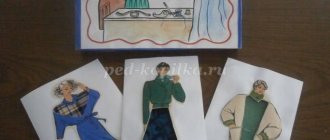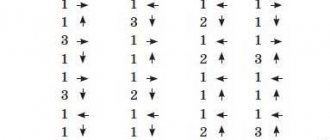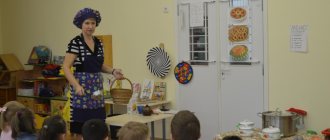Role-playing game "Barbershop"
Summary of a lesson on teaching role-playing games for children of senior preschool age with mental retardation
The play activity of preschoolers with mental retardation differs from the play of normally developing peers, first of all, by monotony, lack of creativity, weakness of imagination, insufficient coordination of play actions, and non-compliance with game rules. Meanwhile, a child who has not fully mastered the game will not be able to move on to the next leading activity – learning. In this regard, the problem of developing games (especially creative ones, including role-playing games) for the development of children with mental retardation and the successful correction of disorders becomes especially urgent. To reduce factors that negatively affect the development of gaming skills by preschoolers with disabilities and improve socialization, we conduct classes to teach children to play. This lesson uses techniques that help children master creative play and develop compensatory functions. This is, for example, creating a gaming environment before the game starts; viewing the presentation, looking at the illustrations with an emphasis on significant points; exercises in game actions; selection of paraphernalia together with children, making it with your own hands; verbalization of one's own actions.
To prepare for such classes, we conduct a variety of virtual excursions, transformation games, improvisation games, game situations, immersing children in various emotional states, organize didactic games, experimentation, modeling, productive activities; With their parents, our students visit social and industrial facilities (in this case, a hairdresser).
Tasks:
- expand children’s life experience, teach them to apply it in play activities;
- learn to formulate a game plan and implement it according to the intended algorithm;
- form speech mediation of activity;
- develop the ability to interact with peers in the process of unfolding the game plot.
Equipment
: presentation “The work of a hairdresser”, cards for the game “What is extra”; background and ready-made forms for applique, oilcloth, glue stick; dolls with long hair, a themed set “Barbershop”, a mirror, high chairs; catalogs with hairstyles, elastic bands, hairpins, aprons, badges.
Progress of activities
Teacher
: Guys, do you know a master who is good with scissors, a comb, a hairdryer, and can help people prepare for the holiday and make them more beautiful?
What kind of master do you think this is? ( Children's answers.
) Do you want to play hairdresser yourself?
( Children's answers.
)
Teacher
: To adjust your attention, we will do a warm-up with you: “Show me what I say, not what I show.”
( The teacher names parts of the body and touches them (forehead, stomach, knee, elbow, etc.). At some point, the teacher names one thing and touches another. For example, touches the back, says the stomach. Children must show what the teacher called.
) Guys, how can you call in one word what we showed you?
( Body parts
.) Well done to those guys who were attentive and didn’t make a mistake.
Teacher
: (
Showing the presentation “The work of a hairdresser.”
) Guys, what is shown here?
( Hairdresser
.) Let's learn about the professions of people working in a hairdresser.
Teacher
: (
There is a picture of “Administrator” on the slide
.) What kind of work do you think an administrator does?
( Schedules clients for haircuts and hair coloring at a time convenient for them.
) What items does the receptionist use?
( Phone, pen, magazine
.) What should it be like?
( Polite
.) Guys, who do we call clients?
( Children's answers
.)
Teacher
: (
On the slide is a picture of “Cashier
.”) What does a cashier do?
( Accepts payment for the service performed, gives change, knocks out a check.
) What tools does he use?
( Cashier, terminal, calculator, pen
.) What should a cashier be like?
( Children's answers
.)
Teacher
: (
On the slide there is a picture “Hairdresser”
.) Guys, who can be called a hairdresser?
( A master who works on creating hairstyles.
) What does a hairdresser need to work?
How should a hairdresser communicate with clients? ( Be polite, attentive, careful, patient
.)
Teacher
: (
On the slide there is a picture “Cleaning lady.”
) What does a cleaning lady do?
( Sweeps, mops floors, changes used towels
.)
Teacher
: (
On the slide is a picture “Manicurist.”
) What does a manicurist do?
( Does a manicure, cuts and paints nails.
) What tools does a master need?
( Nail scissors, files, tongs, varnish
.)
Teacher
: Guys, what rules of behavior exist between clients and hairdressing salon employees?
( They must be mutually polite.
)
Teacher
: And now we’ll play the game “What’s extra.”
Let's remember the rules. It is necessary to select an image of an extra object on each game card. ( The game cards show tools (scissors, comb, hair clips, pliers ), electrical appliances (hair dryer, mixer, terminal, hair curling iron), furniture (wardrobe, bedside table with mirror, bookcase, swivel chair). After each When choosing children, the teacher asks questions: Why is the subject superfluous? How can you call them in one word?
)
Teacher
: Guys, let's continue our activity in the creative workshop.
( We invite children to make hairstyles for the dolls for the holiday. Ready-made forms are laid out on the table. Children have the opportunity to choose a hairstyle and an image of the doll. Children comment on their actions. For example: “This girl’s name is Dasha. I want to make her braids with red bows. I’ll take braids, I’ll turn it over and put it on oilcloth, spread it with glue, glue it, smooth it out.”
)
Teacher
: Guys, imagine that we are going with you to a holiday.
What do you think is needed for this? ( The teacher leads the children to the idea that they need to look smart, and suggests that they go to the hairdresser to do this. The distribution of roles is carried out using a random selection technique: images of hairdresser workers are printed on cards. The cards are turned upside down with the image. Children take a card and perform the corresponding role
.)
Teacher
: After such a hard day at work, you need to rest a little.
Let's do a relaxing exercise called "Washing Your Hands." You need to rub your tense palms together, then “shake off the water” from your relaxed hands, using gentle movements to “wipe your hands” with an imaginary towel. ( Repeat several times
.)
Marina Svyatkina, Marina Savelyeva, teachers,
Alsou Antonova, teacher-defectologist, Oksana Kuznetsova, teacher-speech therapist, MBDOU No. 101, Ulyanovsk
How do you like my new image?
I got my hair cut for spring and dyed my hair creatively.
Before that, I wore a completely different hairstyle with her, I looked like Yulia Menshova... But the hair grew back and this is what happened to my head), but this is so little about myself
I wonder who I remind you of with this hairstyle? What do you say?
By the way, it was not in vain that I started talking about haircuts and dyeing: today I want to tell you what attributes a group should have for the role-playing game “Barbershop”. It seems that all educators should know such obvious things, but it turns out that young specialists experience difficulties arranging thematic corners for role-playing fun. Many beginning teachers are either embarrassed or do not want to look like unqualified teachers and therefore do not ask for help from a methodologist or senior colleagues. Young people want to do everything on their own.
Well, let us help you collect the necessary attributes of the role-playing game “Barbershop”!
By the way, there are excellent didactic materials (according to the Federal State Educational Standard) in the form of colorful cards, which will not only help in planning joint socializing activities of children and the teacher, but will also be useful during thematic conversations, classes, and observations.
Regarding the question: whether to sew overalls and capes for a children's barber shop yourself or buy ready-made ones, I personally prefer factory-made products that meet sanitary and age standards for children's institutions. On the Internet there are very beautiful attributes of the story game “Barbershop” at absolutely inexpensive prices.
Summary of the role-playing game “Beauty Salon” in the preparatory group
Visitor:- Hello, please dye my hair and give me a haircut.
Hairdresser:
- Please sit down in the chair. What color would you like to dye your hair?
Visitor:
— In chestnut.
Hairdresser:
-Fine. Let's look at the catalog and choose a brand of paint.
Visitor:
“I can’t make a choice myself, please help me.”
Hairdresser:
— I suggest the Color brand, it lasts a long time on the hair and is inexpensive.
Visitor:
- Now let's get a haircut.
Hairdresser:
-What kind of haircut would you like to have?
Visitor:
— I like my “Cascade” haircut.
Hairdresser:
- I’ll give you this haircut now.
Visitor:
— I need to pay for coloring and cutting. How much will it cost?
Administrator:
-800 rubles. Take the check, please.
Visitor:
-Goodbye.
Administrator: —
Come visit us again.
Visitor:
-Thank you, I'll come.
Hairdresser:
-Please pass. What do you want to do?
Client:
-I want a new haircut.
Hairdresser:
-Okay, sit down in the chair. -What kind of haircut should you get?
Client:
- “Under the comb.”
Manicurist:
- Hello! What do you want?
Client:
— Please give me a beautiful manicure)
Client:
- Thank you! What a beauty!
Manicurist:
— Please contact the administrator to pay.
Visagiste:
- Hello, take a seat in the chair.
What kind of makeup would you like to do? Festive, everyday? ( Offers to look at the magazines)
Client:
-Everyday.
Client:
-Goodbye. I liked the service in your salon. I wanted to come to you next time.
Administrator:
- We are very pleased to hear this. Thank you. I'll give you our business card. Goodbye. Come back next time.
Client:
— Hello, do you have massage services?
Administrator:
-Yes, we have a new service - massage. This is very useful and allows you to relax.
Masseur:
- What can I do for you?
Client:
- Oh, you know, my neck hurt so much! Please give me a massage.
Masseur:
- Okay, make yourself comfortable
Client:
- Thank you very much! Now I feel so good! Nothing hurts at all.
Masseur:
- This is my job. Contact us. 100 rubles from you. Please pay at the administrator.
Client:
- Goodbye!
Security guard:
- Announces over the loudspeaker: “Attention, attention! Dear clients, our salon closes in 15 minutes, we are waiting for you every day from 9 to 18 hours, without a lunch break.
Game "Paper Barber Shop"
Daria Yakimenko
Game "Paper Barber Shop"
— white paper
— colored paper
We draw funny faces (they can be girls or boys, grown girls or men, or even grandparents) and then cut them out.
After that, we turn on all our imagination and make different hairstyles, mustaches, and beards.
Hair can be tied into a bun, curled, or even cut.
Girls' hair can be tied up in a bun, curled, or even cut.
That’s how all the “clients” with their hair are, satisfied and happy.
Let the child practice with scissors himself and do his clients' hair.
Consultation “Paper Story” Paper Story “Children should live in a world of beauty, games, fairy tales, music, drawing, fantasy, creativity” V. A. Sukhomlinsky One of the priorities.
Notes on the management of the role-playing game “Barbershop” in the second junior group I Management tasks. 1. Enrich children's gaming experience by combining individual actions into a single storyline. 2. Consolidate role-playing roles.
Synopsis of the role-playing game "Barbershop" in the second junior group Synopsis of the role-playing game "Barbershop" Program content: encourage children to perform game actions (hairdresser - cutting hair,...
Synopsis of the plot-role-playing game “Barbershop” Second junior group Goal: to continue to acquaint children with the profession of a hairdresser, his working conditions and the result of labor, to develop the ability to come up with a simple one.
Summary of a lesson using a role-playing game in the second junior group “Hairdressing” Age group: 3-4 years. Topic: "Hairdressing salon". Goal: development of children's gaming experience through the development of initial role-playing concepts.
Project “Paper Filigree” Additional program for group activities “Paper Filigree” Direction: artistic and aesthetic development (for children 5-7.
Project of the plot-role-playing game "Barbershop" in the second junior group Project of the plot-role-playing game "Barbershop" in the second junior group of the Frunzensky district kindergarten No. 80 Goal: To activate educational activities.
Game “Paper Doll” Few modern children are familiar with playing with paper dolls. But in the 20th century it was very popular. I decided to introduce the kids.
Source





